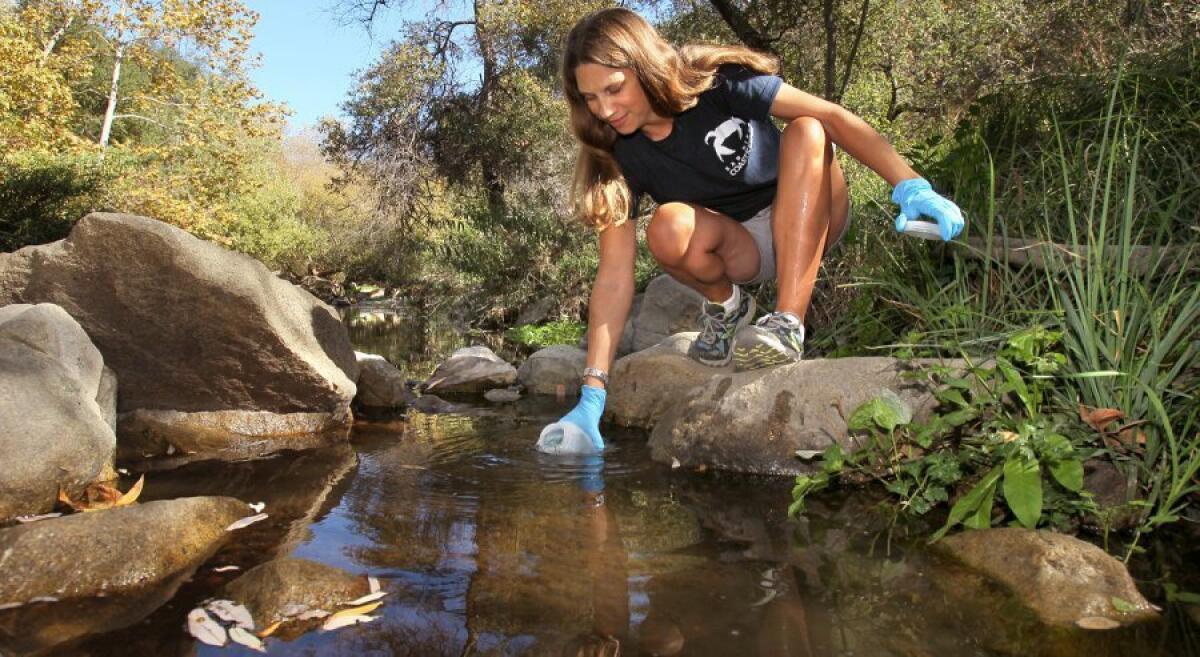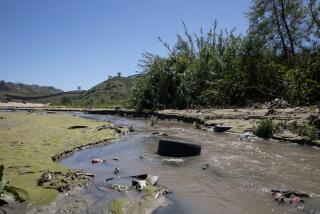Drought harming water quality in inland San Diego County

- Share via
San Diego County’s inland water quality is suffering amid the ongoing drought, according to a new San Diego Coastkeeper report that found high amounts of bacteria and low oxygen levels in the region’s creeks and streams.
Coastkeeper’s 2015 Water Quality Report, released Tuesday, ranked the area’s inland water quality as fair to poor, with no watershed earning “good” or “excellent” status.
The county’s northern watersheds received “fair” ratings. Most central and southern watersheds received marks of “marginal,” while the Tijuana area was rated “poor.”
After four dry years, San Diego remains in a state of extreme drought. Rainfall for the year to date is 7.85 inches, compared to an average of 10.01 inches, said Brett Albright, a meteorologist with the National Weather Service.
Join the conversation on Facebook >>
Without enough rain, the flushing and churning needed for normal stream function may be impaired, contributing to worsening water quality.
Coastkeeper compiled the report using data from about 360 samples taken at various sites throughout the year, with the help of nearly 200 volunteers. Each sample was tested for three different bacteria counts, dissolved oxygen, nitrates, temperature and pH, among other measures.
What jumped out most were fecal indicator bacteria, including E. coli and enterococcus bacteria, which flag possible water contamination. These common bacteria don’t necessarily cause disease themselves, but can signal the presence of other harmful microbes that lead to ear infections, rashes and stomach ailments among swimmers.
“We saw very high levels of fecal indicators this year, with 75% having unsafe levels,” said Coastkeeper program manager Travis Pritchard. “After a rainstorm, almost all come back with high fecal indicators.”
These bacteria are responsible for beach closures, and can also make it unsafe to fish. They typically come from urban runoff, although in specific places, such as La Jolla Cove or La Jolla Children’s Pool, they may be linked to marine mammals and other wildlife.
Low oxygen is really an indicator of a collapsed ecosystem.
— Coastkeeper program manager Travis Pritchard
The Tijuana River area registered the worst water quality because of raw sewage and trash that flows into the waterway during wet weather, according to San Diego County’s website. As of May 6, beach closures have been in effect between the border and Coronado because of that problem.
Coastkeeper’s water monitoring also showed low dissolved oxygen in 31% of samples, a sign that the streams aren’t healthy for fish, insects and other aquatic life.
“Think about what lives in the stream — the bugs and the fish — all the wildlife that uses the stream as its habitat.” Pritchard said. “Low oxygen is really an indicator of a collapsed ecosystem.”
NEWSLETTER: Get the day’s top headlines from Times Editor Davan Maharaj >>
Oxygen levels rise when high amounts of nutrients, such as agricultural fertilizers or lawn amendments, trigger growth of algae. These blooms kill other aquatic plants, and then die off themselves. Bacteria that consume the rotting vegetation siphon oxygen from the water, perpetuating the cycle of death and decay.
Drought conditions also slow the flows of waterways and raise their temperature, strangling San Diego streams, the Coastkeeper report stated.
“With really warm, low, slow-moving flows, we’re not seeing the turbulent mixing that needs to happen to enrich the stream with oxygen,” Pritchard said.
Brennan writes for the San Diego Union-Tribune.
ALSO
After an ugly brawl, Sylmar High students walk out and hold ‘peace rally’
Video: Deputies, bystander pull driver from burning car wreck in Palmdale
Lanes reopen after big rig crash shuts down 10-110 Freeway transition for hours
More to Read
Sign up for Essential California
The most important California stories and recommendations in your inbox every morning.
You may occasionally receive promotional content from the Los Angeles Times.










